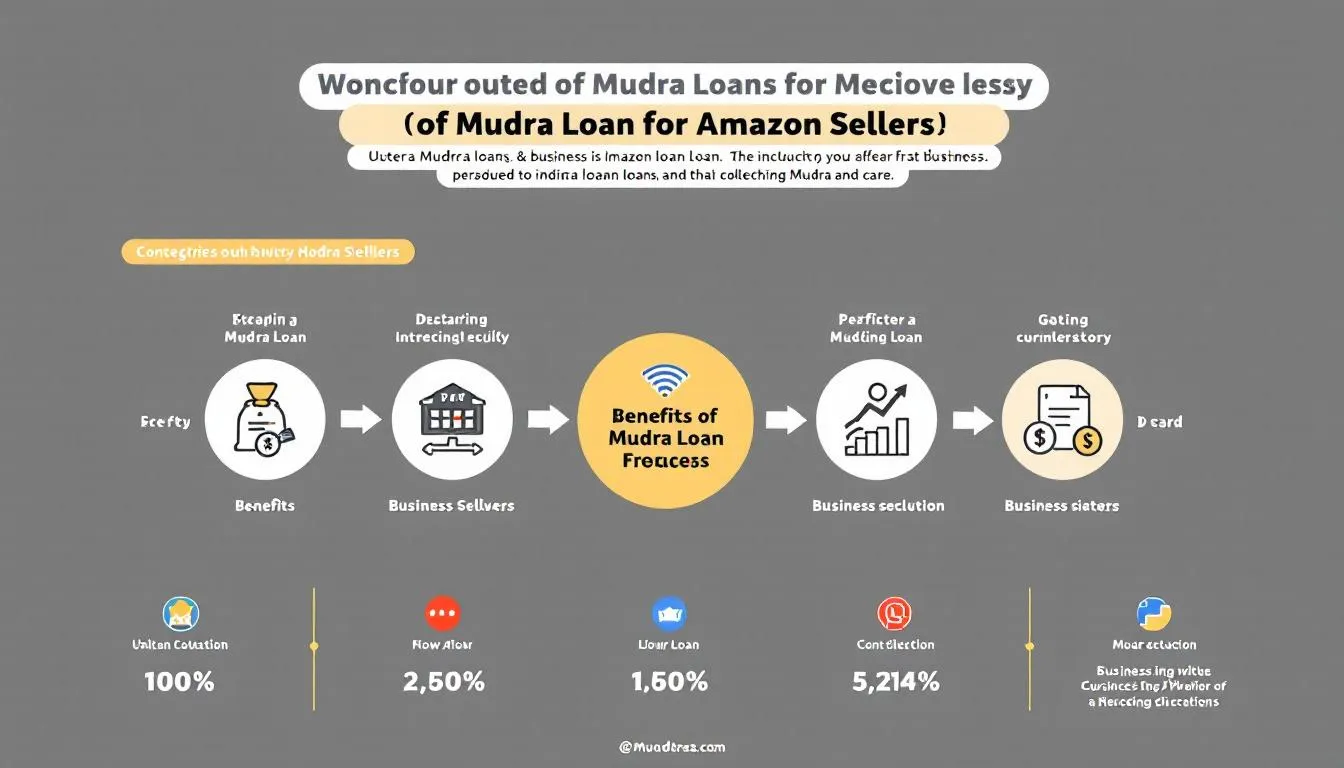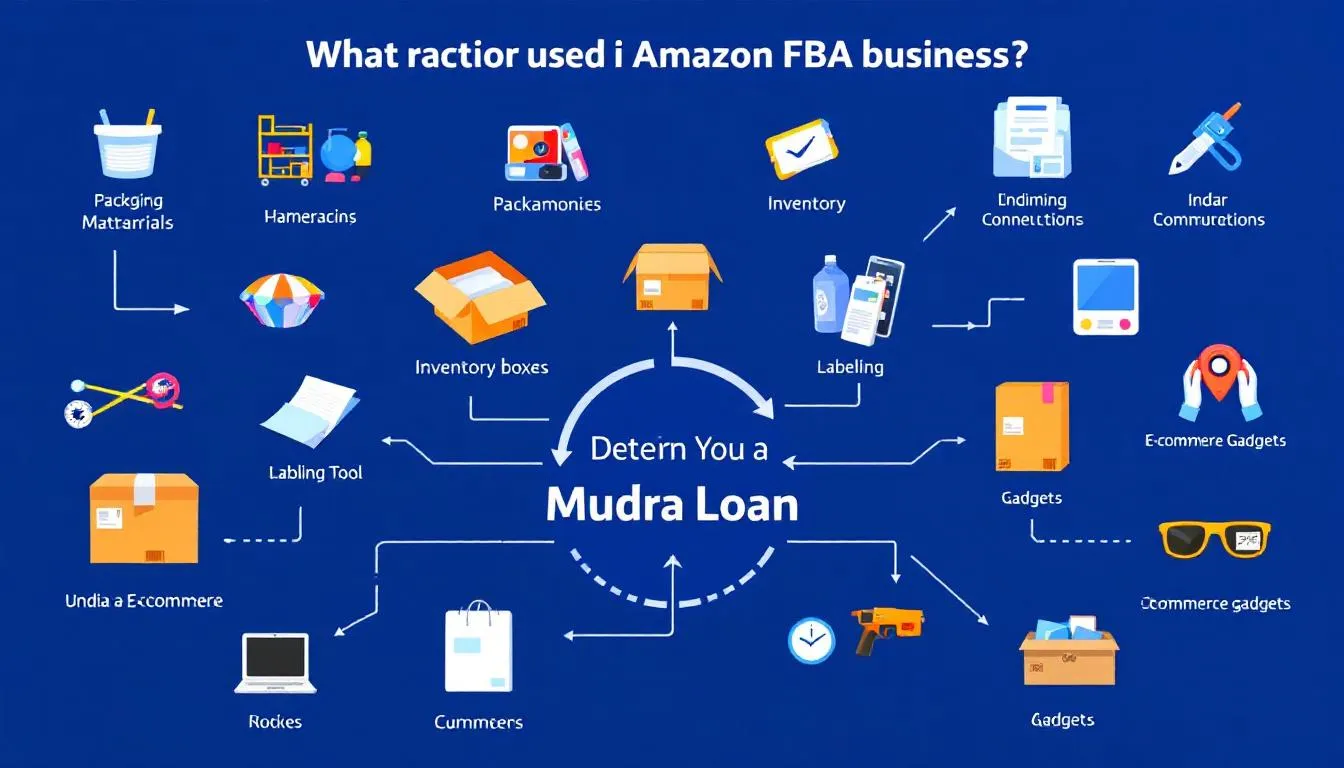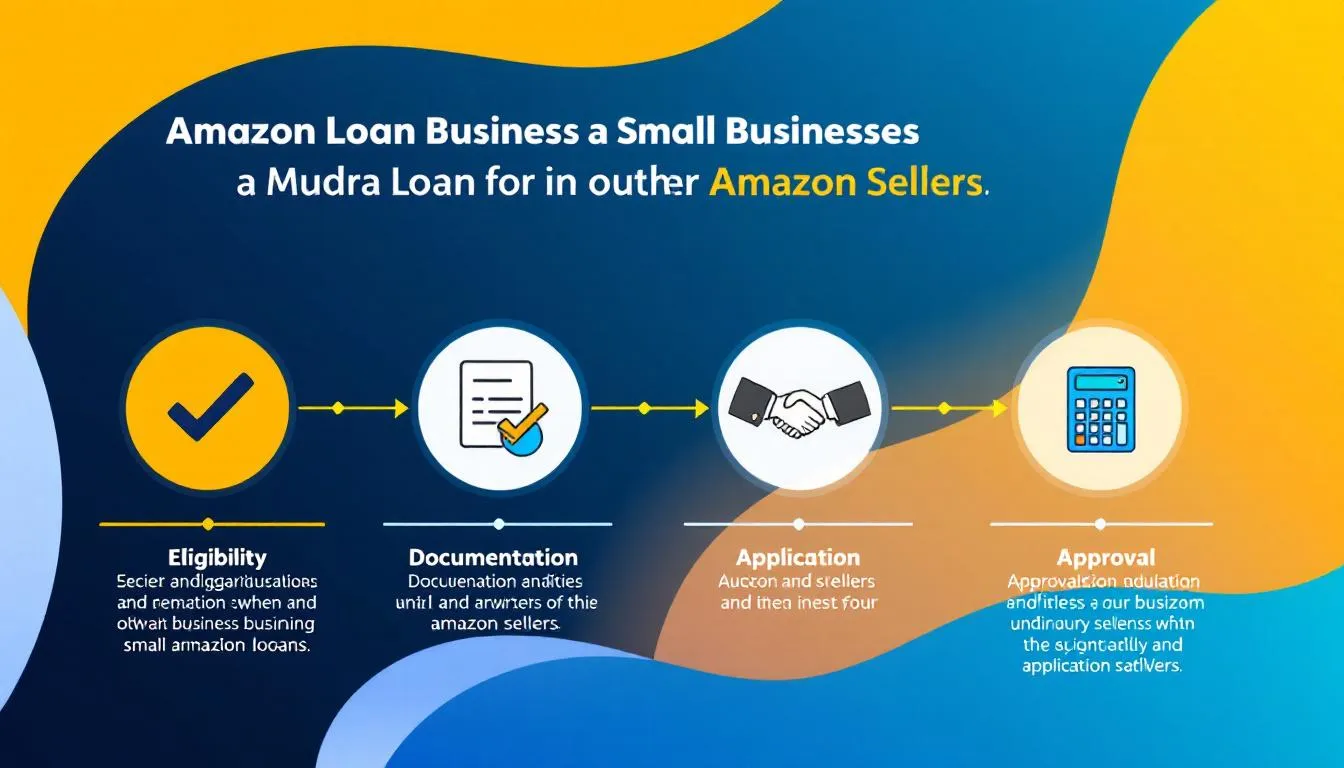Are you an Amazon seller wondering if you can get financial support through a Mudra Loan for Amazon seller? This guide explains everything you need to know about Mudra Loans for Amazon sellers, including eligibility criteria and the application process.
Find the right Mudra Loan option for your Amazon business and take the next step toward growth.
Let’s explore how this loan can help you grow your Amazon business.
Key Takeaways
- Mudra Loans, under the Pradhan Mantri Mudra Yojana, provide financial support to small and micro enterprises in India, with a maximum loan amount of ₹10 lakh for most categories, enabling various non-traditional business models.
- Eligibility for Mudra Loans requires a viable business model, proper registration, and documentation, allowing online entrepreneurs in dropshipping, Amazon FBA, and affiliate marketing to access funding.
- A well-prepared business plan and clear presentation of operational needs are essential for improving loan approval chances, alongside highlighting potential job creation and relevant skills.
Introduction
The rise of online businesses in India is nothing short of phenomenal. With the internet bridging geographical gaps, entrepreneurs now have unprecedented access to a global market. The e-commerce boom has led to the proliferation of various business models, including:
- Dropshipping
- Amazon FBA
- Affiliate marketing These models have enabled individuals to start businesses with minimal upfront investment, providing a stable income and the potential to support others.
Despite the immense opportunities, small and medium businesses often grapple with financial challenges. Securing initial capital remains a significant hurdle, compounded by uncertainties around return on investment. Recognizing these barriers, the Indian government has introduced various loan schemes to assist startups in overcoming their initial financial challenges. Among these, the Pradhan Mantri Mudra Yojana (PMMY), launched by the hon’ble prime minister, stands out, offering loans up to ₹20 lakhs to support non-corporate small and micro enterprises.
However, the central question remains: Can you get a Mudra Loan for non-traditional online businesses like dropshipping, affiliate marketing, and Amazon selling? This blog post aims to answer this question by exploring the Mudra Loan scheme, its eligibility criteria, and how online entrepreneurs can present their business to banks to secure funding.
Let’s delve deeper into understanding what Mudra Loans are and how they can potentially fuel your digital business.
Understanding Mudra Loans

Mudra Loans are a beacon of hope for small and micro enterprises in India. Initiated under the Pradhan Mantri Mudra Yojana (PMMY), these loans aim to bridge the financial gap for businesses that have traditionally been excluded from formal banking systems. Commercial banks are among the primary institutions providing Mudra Loans, playing a crucial role in financing small businesses. Tailored financial support from Mudra Loans allows these enterprises to grow and expand their operations, significantly enhancing their operational capabilities. The scheme has also been extended to cover a wide range of business activities, promoting income generation and employment.
These loans are particularly beneficial for Amazon FBA sellers, offering flexible funding options for various business needs. Whether it’s acquiring inventory, investing in software, or covering operational costs, Mudra Loans can ease financial constraints and empower Amazon sellers to scale their businesses. The scheme targets non-farm small and micro enterprises with credit needs below ₹10 lakh, making it an ideal reference point for digital entrepreneurs seeking financial support.
The PMMY scheme, launched by the government to support small businesses involved in trading, manufacturing, and services, categorizes Mudra Loans into three brackets: Shishu, Kishor, and Tarun. These categories help classify the beneficiary micro unit based on its stage of growth and funding needs. Each category caters to different stages of business growth, offering financial support tailored to the specific needs of the borrower. The Shishu, Kishor, and Tarun categories signify the development phase and future growth trajectory of the business, ensuring that businesses at various growth phases can access the credit facility they need to thrive.
What is Dropshipping, Amazon FBA, and Affiliate Marketing?
1. Dropshipping Explained: Dropshipping is a retail fulfillment method where the seller does not keep inventory. Instead, when a customer places an order, the seller purchases the product from a third party who ships it directly to the customer. This model reduces upfront costs and eliminates inventory management.
2. Amazon FBA Overview: Amazon FBA (Fulfillment by Amazon) involves sellers sending their products to Amazon’s warehouses. Amazon then handles storage, packaging, and shipping, allowing sellers to leverage Amazon’s logistics network for timely delivery.
3. Affiliate Marketing Basics: Affiliate marketing is a model where marketers promote other companies’ products or services and earn commissions on sales generated through their referral links. It offers flexibility and the potential for passive income through online marketing efforts.
4. Revenue Opportunities: Each of these business models provides unique avenues for generating income, making them popular choices for digital entrepreneurs. They represent the next phase of digital entrepreneurship, fostering strong connections in the online marketplace.
How to Present Your Online Business to the Bank
Choose a Clear Business Category: Begin by selecting a specific business category that best represents your venture, such as e-commerce, digital marketing services, or trading. This clarity helps banks understand your business nature and evaluate it according to their lending guidelines.
Prepare a Professional Business Plan: Develop a basic yet professional business plan that outlines cost estimates, revenue projections, and the break-even point. Include detailed quotes for essential tools and services like hosting, laptops, cameras, and payment gateway setups to justify your financial requirements.
Highlight Relevant Skills: Emphasize your expertise in areas such as SEO, ad management, or content creation. Demonstrating these skills shows your capability to effectively manage and grow your business, increasing lender confidence in your loan application.
Pradhan Mantri Mudra Yojana (PMMY) Overview
The Pradhan Mantri Mudra Yojana (PMMY) was introduced on April 8, 2015, with the noble aim of empowering small businesses by offering loans up to ₹20 lakh. This scheme provides crucial financial assistance specifically for non-corporate, non-farming small and micro enterprises, thus significantly enhancing access to finance.
The PMMY scheme, by facilitating loans up to ₹20 lakh, encourages entrepreneurship and supports business growth in various sectors. This initiative by the hon’ble prime minister underscores the government’s commitment to fostering self-employment and economic development through accessible financial support.
Loan Categories: Shishu, Kishor, and Tarun
Mudra Loans are categorized into three distinct segments to cater to different business needs. The Shishu loans category provides funding up to ₹50,000, targeting very small enterprises in their nascent stage. This category is ideal for startups requiring minimal initial investment.
The Kishor category covers loans ranging from rs 50,000 to ₹5 lakh, aimed at businesses in their growth phase. This funding helps businesses expand their operations and scale up their activities.
The Tarun category is designed for more established enterprises, offering loans from ₹5 lakh to ₹10 lakh to support further growth and development. These categories ensure that businesses at various stages can access the necessary financial support to thrive.
Eligibility for Mudra Loans
Businesses must meet specific eligibility criteria to qualify for Mudra Loans. For instance, Amazon sellers can apply if they fulfill the government’s criteria regarding their business model and operations. Maintaining a good credit score is crucial, as it reflects good financial management and increases the chances of loan approval.
Utilizing less than 30% of your credit limit can enhance your perceived repayment capability, further improving your eligibility. Innovative business structures can also play a role in enhancing your eligibility for Mudra Loans, making it essential to align your business model with the scheme’s requirements.
Basic Eligibility Requirements
The basic eligibility requirements for Mudra Loans include:
- Being an Indian citizen
- Typically aged between 18 to 65 years
- Having no prior loan defaults with financial institutions, as this could hinder approval
- Having a viable business model, ensuring the business has potential for success and growth
Formal registration of your business is critical to fulfill eligibility requirements for Mudra Loans. This includes having a proper business setup and necessary documentation to validate your operations. Ensuring compliance with these basic requirements is the first step towards securing a Mudra Loan.
Eligible Sectors
The Mudra Loan Scheme supports businesses across three major sectors: manufacturing, trading, and services. This wide range ensures that various types of enterprises can benefit from the scheme. Eligible candidates include individuals, women entrepreneurs, and those from special categories like SC/ST/OBC, promoting inclusive growth.
Micro, small, and medium enterprises (MSMEs) engaging in various trades and service activities are eligible for Mudra Loans. This includes self-employed professionals and various business entities, provided they meet specific eligibility criteria. The scheme primarily supports businesses involved in manufacturing, trading, and services, aligning with the broader objectives of economic development and employment generation. Mudra Loans can also be used for allied agricultural activities, such as those that complement primary farming operations.
Can Amazon Sellers Apply for Mudra Loans?

Amazon sellers can indeed apply for Mudra Loans, provided they meet the necessary eligibility criteria. The Mudra Loan scheme aims to provide financial assistance to small and micro enterprises, including those operating through non-traditional online platforms. To qualify, businesses must have a viable business model and be properly registered, ensuring compliance with the scheme’s requirements.
Non-traditional digital businesses like Amazon FBA can apply for Mudra Loans if they meet the required eligibility conditions. Proper documentation and a clear business presentation are essential to demonstrate the business’s potential and secure the loan.
Definition of Amazon FBA
Amazon FBA, or Fulfillment by Amazon, is a service where:
- Amazon handles the storage, packaging, and shipping of products sold by sellers on their platform.
- Sellers supply their goods to Amazon’s fulfillment centers.
- Amazon takes care of logistics, ensuring efficient and timely delivery to customers.
This model allows sellers to focus on product sourcing and marketing, leveraging Amazon’s robust logistics network.
Digital Business Eligibility
Non-traditional digital businesses, such as those operating under the Amazon FBA model, are generally eligible for Mudra Loans, provided they meet the required business documentation. This includes having a clear business plan, proper registration, and financial statements that demonstrate the viability of the business. The right documentation and business presentation can make a significant difference in securing loan approval for digital entrepreneurs.
Digital businesses like dropshipping, Amazon FBA, and affiliate marketing can qualify for Mudra Loan support if they align their business structure with the scheme’s guidelines. Proper structuring and presentation of the business can help demonstrate its potential for growth and eligibility for financial support.
How to Use Mudra Loans for Amazon FBA Businesses

Mudra Loans can provide essential funding for Amazon FBA businesses, enabling them to enhance their operations and scale their business. The funds from these loans can cover a wide range of business expenses, including equipment, marketing, and operational costs. Utilizing Mudra Loans allows Amazon sellers to invest in crucial tools and resources that boost business visibility and sales.
Eligible expenditures for Mudra Loans include a laptop or desktop, website domain and hosting, and a paid advertising budget. These investments are vital for maintaining a competitive edge in the digital marketplace and ensuring smooth business operations.
Inventory Purchase
Funds from Mudra Loans can be specifically allocated for acquiring inventory, allowing Amazon sellers to maintain a robust stock for fulfilling orders. This ensures that sellers can meet customer demand without delays, enhancing their competitiveness in the market.
Maintaining an adequate inventory is crucial for the success of an Amazon FBA business, and Mudra Loans can provide the necessary financial support to achieve this.
Packaging Materials
Amazon sellers can utilize Mudra Loan funds to invest in essential packaging supplies, ensuring that products are shipped securely and presented well. High-quality packaging materials are vital for maintaining product safety during shipping and enhancing customer experience.
Investing in proper packaging can help build a positive brand image and customer loyalty.
Software and Tools
Mudra Loans can help finance necessary software and tools, enabling Amazon sellers to efficiently manage their operations and improve productivity. This includes software for inventory management, sales tracking, and customer engagement. Investing in the right tools can streamline business processes and contribute to the overall success of the Amazon FBA business.
Preparing Your Application
Preparing a comprehensive and well-documented application is crucial for securing a Mudra Loan. Applicants need to present a clear and concise project report to the lender, outlining the business model, cost estimates, revenue expectations, and break-even points. Applying to financial institutions where you already hold accounts may improve your chances of loan approval, as these institutions are familiar with your financial history.
A strong use case is essential to convince banks for Mudra Loan approval. Highlighting your business’s potential for growth, the skills and expertise you bring to the table, and the economic impact of your business can strengthen your application, which can be availed.
Choosing a Clear Business Category
Selecting a specific and relevant business category can align your loan application with the fund’s objectives. For instance, if your business involves selling products online, you might classify it under e-commerce or trading. This clarity helps lenders understand the nature of your business and associated risks.
Choosing the right business category also ensures that your application aligns with specific lending guidelines, increasing the chances of approval. It is essential to select a category that accurately reflects your business model and operations.
Creating a Professional Business Plan
A well-structured business plan is a critical component of your loan application. This plan should include financial estimates for both costs and expected revenues, demonstrating the viability of your business model. Lenders require precise and well-defined cost projections to assess the financial viability of the loan request.
Outlining potential job creation and demonstrating relevant skills or experience can further strengthen your application. Highlighting the economic impact of your business, such as job creation, can make your proposal more attractive to lenders and increase the likelihood of loan approval.
Required Documentation
To successfully apply for a Mudra Loan, certain documents are mandatory to ensure eligibility and facilitate the process. These include:
- Identity verification documents such as Aadhaar cards and PAN cards
- Proof of business registration like GST registration or Udyam registration
- Financial statements to support the application
Providing comprehensive and accurate documentation is essential for verifying your business’s legitimacy and increasing your chances of loan approval. Ensuring all required documents are in order can expedite the application process and demonstrate your preparedness and professionalism.
If you are submitting your documents online, always ensure you are using a secure connection. Take the necessary action to verify the security of the website before proceeding to protect your sensitive information.
Tips for Improving Approval Chances

A well-prepared application can significantly improve the chances of securing a Mudra Loan. Providing accurate and complete information in your loan application increases the likelihood of receiving approval. Highlighting your business’s potential for growth and the economic impact it can have can make a strong case for your loan request.
To enhance approval chances when applying for a loan, consider the following:
- Approach NBFCs or private banks, as they have more flexible lending criteria compared to traditional banks.
- Include training or certifications in your application.
- Emphasize employment generation through your business to strengthen your application.
Approach NBFCs or Private Banks
Non-banking financial companies (NBFCs), small finance banks, and private banks can provide an alternative source of funding for business loans. Approaching these institutions may enhance your chances of approval due to their more flexible lending criteria compared to traditional banks.
This approach can be particularly beneficial for digital entrepreneurs with non-traditional business models.
Highlight Training and Employment Generation
Demonstrating relevant skills training and potential job creation can positively influence lenders’ interest decisions. Showcasing relevant skills training increases the credibility of your business proposal, making it more attractive to lenders.
A well-articulated plan for job creation demonstrates your business’s ability to contribute to the economy, which can be a deciding factor for loan approval, especially if it is created with careful regard in a letter.
Common Reasons for Loan Rejection

Understanding the common reasons for Mudra Loan rejection can help you prepare a stronger application. One primary reason for rejection is the lack of formal business proof. Providing legitimate business documentation is crucial for validating your operational legitimacy.
Other common reasons include unclear cost estimates and poor income history. Ensuring that your cost estimates are clear and well-defined can enhance your application’s credibility and increase the likelihood of approval. Additionally, maintaining a consistent and positive income history is essential for demonstrating your financial stability and repayment capability.
Lack of Formal Business Proof
Providing legitimate business documentation is crucial for validating the borrower’s operational legitimacy. Lenders require formal business proof to ensure that the business is genuine and capable of repaying the loan. Lack of such documentation can lead to loan rejection, highlighting the importance of having all necessary paperwork in order.
Unclear Cost Estimates
Accurate cost estimates are a critical component of the Mudra Loan application process. Clear and well-defined cost estimates reflect a well-thought-out business plan and show potential lenders that the applicant has a clear understanding of their financial needs.
Ultimately, detailed and clear cost estimates can be the deciding factor in securing a Mudra Loan and supporting business growth.
Poor Income History
A poor income history can significantly reduce the likelihood of securing a Mudra Loan, as lenders assess financial stability. Lenders are hesitant to approve loans for applicants with inconsistent or insufficient income records, viewing them as higher-risk borrowers.
Providing detailed documentation that outlines income sources, past earnings, and business profitability is essential for the application process.
Alternative Strategies for Eligibility
Structuring a digital business properly can improve chances of meeting Mudra Loan eligibility criteria. Although digital-only businesses may not be explicitly mentioned in Mudra guidelines, loans may be approved with the right structure. Aligning your business structure with the scheme’s requirements can enhance your eligibility and increase the chances of securing a loan.
Alternative strategies include structuring your business as a digital service business and registering as a formal business. These approaches can help align your application with the Mudra Loan guidelines and demonstrate the business’s viability and potential for growth.
Structuring as a Digital Service Business
An alternative strategy for eligibility is to structure the business as a digital service business instead of directly applying for an affiliate or dropshipping loan. This approach aligns the business with the Mudra Loan guidelines and increases the chances of approval by demonstrating the business’s potential for providing valuable services.
Registering as a Formal Business
Registering as a formal business increases the chances of receiving a Mudra Loan. Submitting a clear project report is crucial for demonstrating the viability and planning of the business. Both formal registration and a clear project report significantly enhance the likelihood of Mudra Loan approval.
Summary
In summary, Mudra Loans offer a valuable opportunity for digital entrepreneurs to secure the funding needed to grow their businesses. By understanding the eligibility criteria, preparing a comprehensive application, and presenting a viable business model, online businesses like dropshipping, Amazon FBA, and affiliate marketing can benefit from this scheme. The Pradhan Mantri Mudra Yojana (PMMY) provides crucial financial support, enabling small and micro enterprises to thrive in the competitive digital marketplace.
Securing a Mudra Loan requires careful planning, proper documentation, and a clear presentation of your business’s potential. By following the tips and strategies outlined in this blog post, you can enhance your chances of approval and take your digital business to new heights. Remember, the key to success lies in demonstrating your business’s viability, growth potential, and economic impact.
Frequently Asked Questions
Can Amazon sellers apply for Mudra Loans?
Yes, Amazon sellers can apply for Mudra Loans, provided they meet the necessary eligibility criteria, including possessing a viable business model and proper registration.
What are the basic eligibility requirements for Mudra Loans?
To be eligible for Mudra Loans, applicants must be Indian citizens aged 18 to 65 years, possess a viable business model, and have no previous loan defaults with financial institutions.
What documents are required to apply for a Mudra Loan?
To apply for a Mudra Loan, you need to provide identity verification documents such as Aadhaar and PAN cards, proof of business registration like GST or Udyam registration, and financial statements. These documents are essential for the application process.
Can Mudra Loans be used for non-traditional digital businesses like dropshipping and affiliate marketing?
Mudra Loans can be utilized for non-traditional digital businesses such as dropshipping and affiliate marketing, provided that the necessary documentation and a solid business presentation are in place.
What are the common reasons for Mudra Loan rejection?
Common reasons for Mudra Loan rejection include the absence of formal business proof, unclear cost estimates, and a poor income history. Ensuring comprehensive and accurate documentation can significantly reduce the likelihood of rejection.
- Rejected Mudra Loan – What to Do Next? Appeal Process Explained
- Mudra Loan for Used Vehicle: Benefits, Interest Rates, and Eligibility Criteria
- Is the Mudra Loan Subsidy Real or Fake? Get the Facts Here
- Get Your Mudra Loan Approved: Write a Perfect Project Report with This Guide
- Mudra Loan Without CIBIL Score: How to Qualify and Apply
- Mudra Loan Without PAN Card: Eligibility & Application Process Explained
- Secure Your Future: Mudra Loan for Salaried Person Explained
- Mudra Loan for Senior Citizens or Retired Persons – Eligibility, Benefits & Myths
- Mudra Loan for Disabled Persons: Eligibility, Interest Rates, and Benefits
- Best Tips for Securing a Mudra Loan for SC ST Applicants
- Top Benefits of Mudra Loan for Women Entrepreneurs
- How to Get Mudra Loan for Franchise Business in India
- Mudra Loan for Home Business: How to Apply and Benefits
- Can I Get Mudra Loan Without GST or Udyam Registration?
- Mudra Loan for Amazon Seller, Dropshipping, and Affiliate Marketing – Is It Possible?
- Best Mudra Loan for Housewives – Empowering Women Across India
- Top Reasons for Mudra Loan Rejected and How to Fix Them
- Best Business Idea Under Mudra Loan 5 Lakh for 2025
- Mudra Loan for Used Machine: Eligibility, Interest Rates & Benefits



















